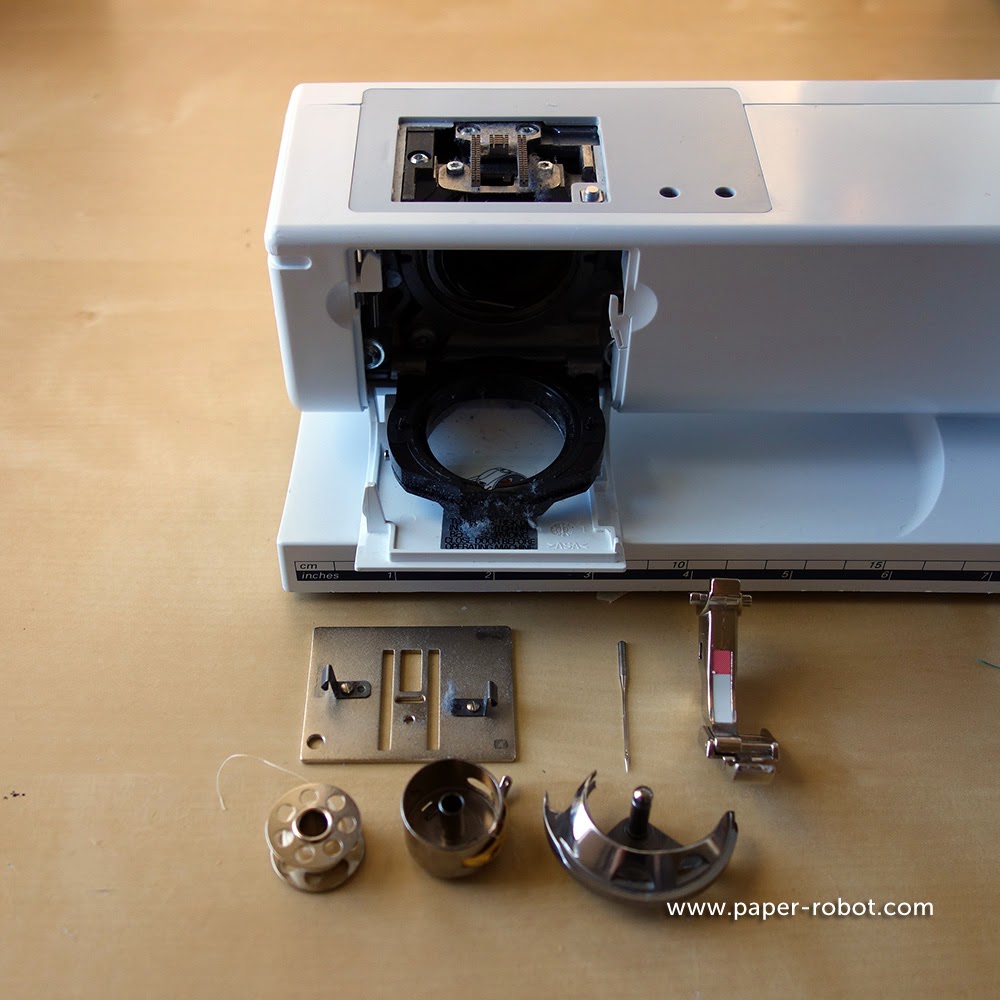It's essential to clean and oil your machine after each project; sometimes you will need to clean more often–ideally, after every few hours of sewing.
Here are some general tips that should know while you're sewing. Tools you should keep on hand include soft tissues, cotton swabs, a cleaning brush, colourless machine oil, and scrap fabric.
A note about machine oil: you definitely want some high-quality, thin, and colourless oil. Do not use automotive oil, because it can damage your sewing machine. Good sewing machine oil is fairly inexpensive, and lasts a long time–the bottle I have cost me $4, and it's still usable four years later.
Every sewing machine is different, and you will want to check with your manual, dealer, or manufacturer on how to access the little parts in yours. Here's all the parts I can get into on my Bernina:
Listed below are some of the key areas that I clean; some of them are the same for drop-in bobbin machines and stationary hook machines.
Needle Plate and Feed Dogs
If you can remove your needle plate, you definitely should. Chances are, there is a ton of lint hanging out near your feed dogs, and that can mess with your machine.
To clean it out, take your brush and push the lint outwards towards you. Try to avoid pushing the lint further into the machine, where you can't get to it yourself.
Dust off that needle plate, too, before you put it back in!
Bobbin Case
Take the bobbin out of the case, and check inside for dirt or lint. Lightly swipe it clean with a cotton swab.
Use a soft cloth to wipe the outside of the bobbin case, but take care not to mess with the tension screw! You can put a little bit of machine oil on the outside if you wish.
Race Hook
If you can get into the parts behind your bobbin case, you might be able to remove the race and hook.
I clean the hook in a similar fashion to the bobbin case, and swab a bit of machine oil on both the inside and outside.
The tricky part about this one is getting it all back in, but it just takes some practice and really good lighting.
The tricky part about this one is getting it all back in, but it just takes some practice and really good lighting.
Other Parts?
I don't have another sewing machine (sergers are different!), so I don't actually know how to clean them out, but I did find a great webpage with some helpful photographs here.
That website also has some scary crazy photos of machines that seem like they have never been cleaned, ever.
Machine Cover
A sewing machine cover is extremely important to have. A cover can keep a lot of dust and fluff out from your machine, especially if you don't clean often (guilty) or have pets. Many machines come with a cover, or you can make one yourself!
Other Tools
Once you've given your machine a light oiling, thread it, grab some scrap fabric and do a few lines of stitches. This should remove most of the excess oil, putting it on the scrap fabric and not your next project.
If you have some lint-free muslin, you can also use it to clean out your tension discs, which I learned from this Threads article. Though, I haven't noticed much lint in that area on my own machine.
Lastly, you can get these vacuum attachments from various places, which have really small bits to get into all the nooks and crannies.
In addition to regular cleanings, if you sew often, you should get your machine serviced every year, to make sure that it gets a thorough cleaning and check-up. You can go back to your dealer, or find a local sewing machine repair shop. Even if you don't sew a lot, your machine would appreciate a checkup every 3-4 years.
I actually prefer this to compressed air, because blowing dust around can push it further into your machine, when you really want to take it out.
In addition to regular cleanings, if you sew often, you should get your machine serviced every year, to make sure that it gets a thorough cleaning and check-up. You can go back to your dealer, or find a local sewing machine repair shop. Even if you don't sew a lot, your machine would appreciate a checkup every 3-4 years.
This can all feel like a lot to take in, and cleaning is a huge drag, especially when you just want to move on to the next cool project. But like exercise and eating all your vegetables* it's important to do for increased longevity, and the more you do it, the easier it becomes.
*I love you, vegetables! I didn't mean anything by it.








No comments:
Post a Comment